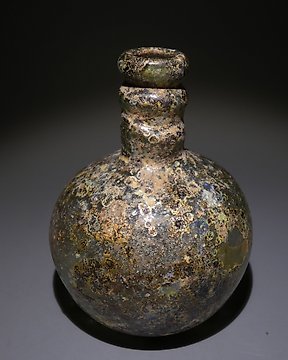
Romain antique Verre Pot. 7 cm H. 1er - 2ème siècle après JC (Sans Prix de Réserve)
Nº 84565561

Nº 84565561

Dish with floral decoration
Middle Eastern, 2nd – 1st Century BC
Faience.
9 cm D.
Condition: Good condition.
Provenance: Private collection, Paris, France. Acquired in the art market during the last 30 years.
Supported by a small ring-shaped foot, the cup has a wide flat rim and a low body whose wall is inclined and straight.
Although highly stylized, the decoration is largely inspired by the plant world: against the light background of the faience, the motif painted in blackish brown sometimes show up in positive, sometimes in negative (flowers). On the inside, linear friezes surround the large tondo composed of a rosette with twelve elongated petals, while smaller flowers and “spoked wheels” alternate on the rim. Lines of different lengths, decorated with tooth patterns, separate the different elements on the rim. The exterior is undecorated.
This piece belongs to a small series of cups that, thanks to a discovery in Palmyra, were dated to the late Hellenistic period. With a size generally ranging between 10 and 13 cm in diameter, they were local imitations – certainly produced in the Near East (Levantine coast, Syria, or the Delta; the exact location remains unknow)- of the more famous and richer Egyptian two-colored faiance cups. Their shape does not display significant variations, and their decoration most often depicts the same motif, with floers or garland, sometimes so stylized that they become unrecognixzable and appear to be simple geometric patterns.
BIBLIOGRAPHY:
- FELLMANN, R., Le sanctuaire de Baalshamin à Palmyre, V : Die Grabanlage, (Rome, 1970), p. 48 and 85, pl. 16.4.
- PARLASKA, K., Ptolemäische Fayencekeramik ausserhalb Ágyptens, in Jahrbuch des deutschen archäologischen Instituts 91 (1976), pp. 144-145, fig. 13-15.
Notes:
The piece includes authenticity certificate.
The piece includes Spanish Export License.
Comment acheter sur Catawiki ?
1. Découvrez des objets d’exception
2. Faites la meilleure offre
3. Effectuez un paiement sécurisé